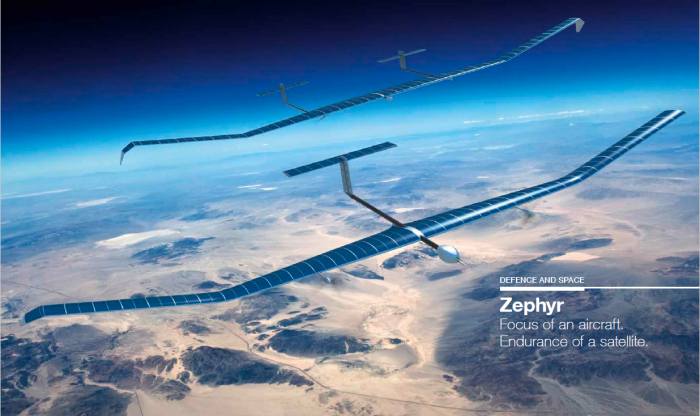
Image: Airbus Defence And Space
Wyndham airfield in Western Australia will be used as an operations base for Airbus’s Zephyr – a 100% solar powered High Altitude Pseudo Satellite (HAPS).
Zephyr can operate at an altitude of 20,000 metres, above turbulent weather and air traffic, providing a range observation services and communications connectivity for remote areas. Its solar cells and lithium sulphur chemistry batteries means it can potentially remain aloft for months.
“It flies autonomously for months, filling a capability gap between satellites and Unmanned Aerial Systems (UAS) by providing an affordable, adaptable and persistent solution,” says Airbus.
The company states replacing one conventional UAS with just one Zephyr would save 2,000 tons of fuel each year.
Western Australian Premier Mark McGowan announced yesterday Wyndham will be the world’s first operational site for the launch and recovery of Zephyr craft, saying it was a coup for the state.
“Our local economy will benefit from this decision, with up to 20 Airbus staff also earmarked to be based in the local area during operational phases,” stated the Premier. ” I am optimistic that early success of the project will lead to expanded job opportunities in the east Kimberley and elsewhere in Western Australia.”
Wyndham was chosen by Airbus due to its largely unrestricted airspace and reliable weather, along with the WA government’s support. Wyndham, 2,210 kilometres northeast of Perth, is the northernmost town in Western Australia’s Kimberley region. No doubt the news will cause quite a stir among the town’s ~600 locals.
It’s expected Zephyr flights will begin in the second half of this year.
There are currently two variants of the Zephyr, S and T. The Zephyr T has a wingspan of over 32 metres, yet only weighs around 145kg thanks to its carbon-fibre construction. The smaller Zephyr S has a wingspan of 25 metres and weighs between 62 and 65kg.
Zephyr’s payload can include HD optical / IR video, NIIRS 6/8 imagery, AIS, narrowband and broadband communications equipment, radar, LIDAR and ESM/ELINT.
The Zephyr, which holds world records for the longest and highest flight, was originally developed by British company QinetiQ in 2003 and sold to EADS Astrium (now Airbus Defence and Space) in March 2013.
Airbus won an order from the UK Ministry of Defence or the manufacture and operation of two Zephyr 8 (now called the S) craft in December 2016.

 RSS - Posts
RSS - Posts



Well, that should have a longer range, and, use less fuel, than a Mk 2 Zephyr,
So, up north, they get solar powered shark patrols…